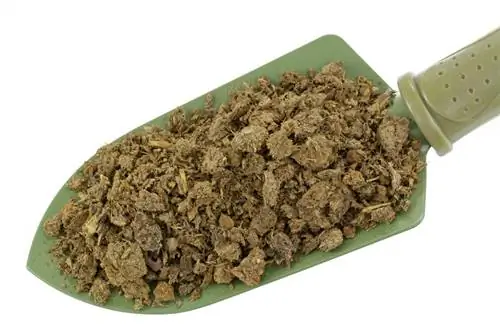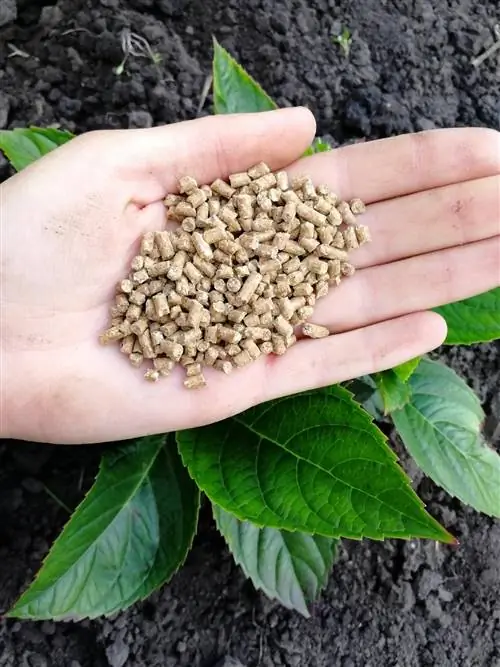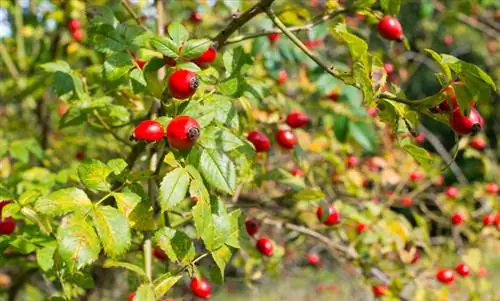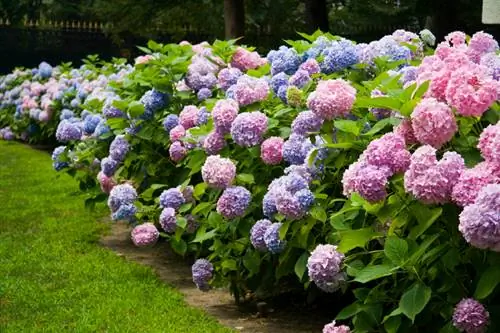- Author admin [email protected].
- Public 2023-12-16 16:46.
- Last modified 2025-01-23 11:20.
Only with a balanced and sufficient diet will farm hydrangeas produce abundant flowers and develop into he althy, strong plants. The emphasis is expressly on “balanced”, because both too much and too little fertilization damages the shrubs in the long term.
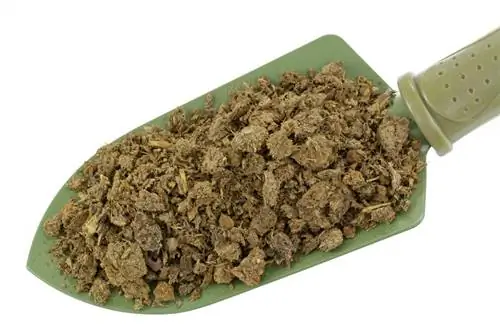
How should you properly fertilize farmer's hydrangeas?
Farmer hydrangeas need balanced fertilization in order to grow he althily and bloom abundantly. Organic fertilizers such as cattle manure or compost are suitable, as are mineral hydrangea, rhododendron or azalea fertilizers. To get blue flowers, provide acidic, alum-containing soil, such as: B. with hydrangea blue or potash alum.
Organic fertilization
Organic fertilizers are made from plant or animal raw materials. They work slowly and evenly because they are only gradually broken down by microorganisms living in the soil. The microorganisms work faster at higher temperatures and correspondingly slower at lower temperatures. In any case, it takes around three to four weeks until the plants can absorb the fertilizer applied. The group of organic fertilizers includes, among others: mature compost, horn shavings and cattle dung.
Fertilize farm hydrangeas with cattle manure
Well-seasoned cattle manure (but not horse manure!) is one of the best organic fertilizers for farmer's hydrangeas because it has the right composition of nutrients and does not contain too much nitrogen. In addition, mixed compost is also ideal for fertilizing hydrangeas. However, organic fertilizers have a serious disadvantage: their nutrient composition varies greatly because, among other things, depends on the nutrition of the animals or plants.
Mineral fertilization
Mineral fertilizers, on the other hand, are water-soluble and immediately available to the plants. They are commercially available in various mixtures or as individual minerals. Phosphate, potash and nitrogen belong to this group. When using it, you should keep in mind that any excess cannot be absorbed by the plants, but instead ends up in the groundwater. Therefore, even if you have a high nutrient requirement, you should fertilize more often but more sparingly. A special hydrangea fertilizer (€8.00 on Amazon) is very suitable for farm hydrangeas, but rhododendron or azalea fertilizer also contains the right nutrient composition. However, universal fertilizer (e.g. blue grain) is unsuitable due to the high phosphate content.
Fertilize hydrangeas with blue flowers
The flower color of farm hydrangeas is naturally white, pink or red. Blue flowers can only be achieved through targeted treatment of the soil. Responsible for the blue color is the dye delphinidin, which in the presence of the aluminum compound alum turns the flowers blue. If you want intensely blue-flowering varieties to stay that way, you must ensure that the soil is acidic and contains alum. The necessary alum is added to the soil with the irrigation water. To do this, you can either buy a ready-made preparation from a gardening store, the so-called hydrangea blue, or you can go to the pharmacy and get potash alum (potassium aluminum sulfate), which is usually cheaper.
Tips & Tricks
A particularly valuable compost ingredient for farmer's hydrangeas is old coffee grounds. It's even worth creating your own compost area where you collect a higher proportion of filter bags and shredded material. This natural fertilizer is suitable not only for hydrangeas, but also for evergreen plants and conifers.

